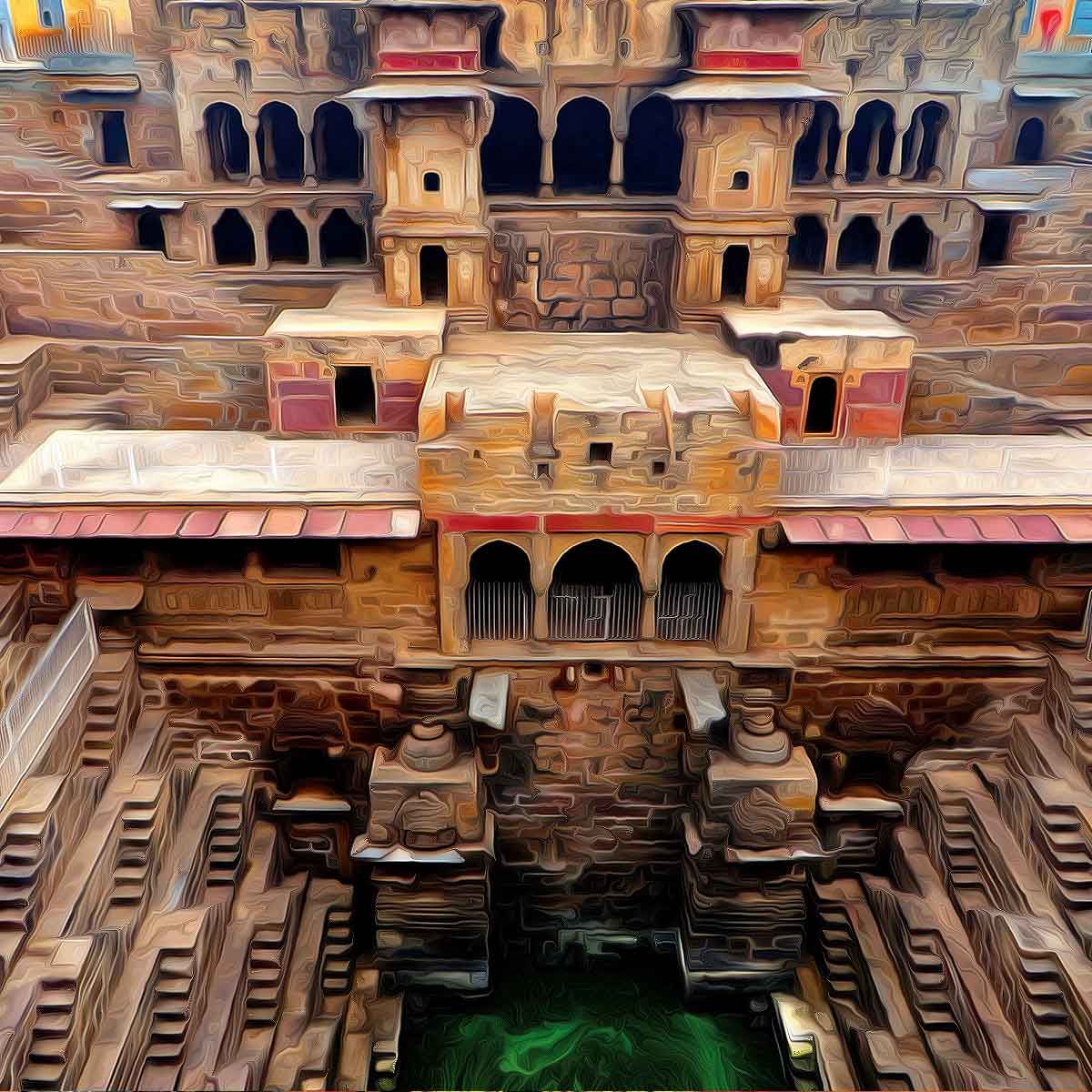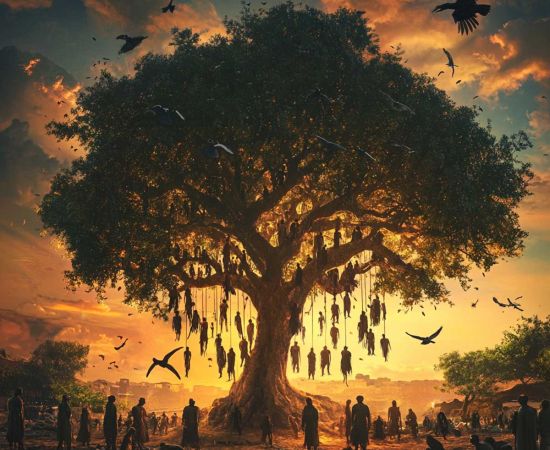MORE COVERAGE
Twitter Coverage
Satyaagrah
Written on
Satyaagrah
Written on
Satyaagrah
Written on
Satyaagrah
Written on
Satyaagrah
Written on
JOIN SATYAAGRAH SOCIAL MEDIA
"It’s not what you look at that matters, it’s what you see": Chand Baori - A fascinating story of the largest and deepest stepwell in India, Abhaneri Stepwell that consists 3,500 narrow steps over 13 stories and extends 30 metres into the ground

IN 1864, THE FAMOUS FRENCH world traveler Louis Rousselet described “[a] vast sheet of water, covered with lotuses in flower, amid which thousands of aquatic birds are sporting” at the shores of which bathers washed, surrounded by jungle greenery. He was not describing a lakeside scene or one of India’s famous riverside ghats, but an ancient well, as big as a large pond.
|
In the northern Indian states of Rajasthan and Gujarat, the problem of water is a profound one. At the edge of the Thar desert, the area sees torrential seasonal monsoons, and then watches the water disappear almost immediately. With summers routinely over 100 degrees, and silty soil that would not hold water in ponds, a practical solution was needed for locals and travelers along the local trade routes.
In the first century, the slippery shores of the major rivers were tamed by the construction of ghats, long, shallow sets of stairs and landings. The same approach was applied to the construction of a new kind of well.
The earliest stepwells most likely date to about 550, but the most famous were built in medieval times. It is estimated that over 3,000 stepwells were built in the two northern states. Although many have fallen into disrepair, were silted in at some point in antiquity, or were filled in with trash in the modern era, hundreds of wells still exist. In New Delhi alone, there are more than 30.
Chand Baori in Abhaneri, near Jaipur, Rajasthan, is among the largest, if not the largest, of the stepwells. It is also perhaps the most visually spectacular: Chand Baori is a deep four-sided structure with an immense temple on one face. Some 3,500 Escher-esqe terraced steps march down the other three sides 13 stories to a depth of 100 feet. The construction dates to the 10th century, and is dedicated to Harshat Mata, goddess of joy and happiness.
Water plays a special part in Hindu cosmology, as a boundary between heaven and earth known as tirtha. As manmade tirtha, the stepwells became not only sources of drinking water, but cool sanctuaries for bathing, prayer, and meditation. The wells are called by many names. In Hindi they are baori, baoli, baudi, bawdi, or bavadi. In Gujarati, spoken in Gujarat, they are commonly called vav.
The architecture of the wells varies by type and by location, and when they were built. Two common types are a step pond, with a large open top and graduated sides meeting at a relatively shallow depth. The stepwell type usually incorporates a narrow shaft, protected from direct sunlight by a full or partial roof, ending in a deeper, rounded well-end. Temples and resting areas with beautiful carvings are built into many of the wells. In their prime, many of them were painted in bright colors of lime-based paint, and now traces of ancient colors cling to dark corners.
The use and conditions of stepwells began to decline in the years of the British Raj, who were horrified by the unsanitary conditions of these drinking water bathing spots. They began to install pumps and pipes, and eventually outlawed the use of stepwells in some places.
The remaining stepwells are in varying states of preservation, and some have gone dry. Local kids seem to find the ones with water to be terrific diving spots, which seems insanely hazardous.
|
Fascinating story of Abhaneri Stepwell
Situated in the desert state area, the original purpose of building the Abhaneri Step Well was to store water since the region experiences dry monsoons. Due to this, water scarcity has always been a major issue and to counter this, Raja Chanda built the stepwell.
Along with being an excellent water management system, these stepwells also provide coolness in the atmosphere in the summer season. The bottom of the well is five to six degrees lower than the regional temperature. The architecture also boasts of natural light and air that further keeps the temperature lower. For instance, the jharokhas, native to Rajasthani culture, allow sunlight and wind to pass through.
Another reason behind making a water management system so architecturally beautiful is that the stepwell became a venue for entertainment and performing arts and ritual ablutions in the nearby Harshat Mata Temple.
Also, the locals would assemble on the steps for community meetings, performances or social gatherings. This explains the huge performing stage that is also part of this structure. On the floor there are platforms for games resembling chess (shatranj), which indicate that apart from being a place of worship, it was also a place of public meeting.
History of Abhaneri Chand Baori
Chand Baori is the oldest stepwell in Rajasthan and probably the whole of India, which is still alive. This deepest stepwell in India was built in the 8th century by King Chanda of the Nikhumba Dynasty which ruled the region for almost 400 years. Raja Chanda had his faith in Harshat Mata, the goddess of joy and happiness. To please Harshat Mata and help the people in his kingdom, Raja Chanda built this step well. Also, there was a temple attached to the stepwell dedicated to Harshat Mata.
In the 18th century when the Mughals invaded the region, they rebuilt the stepwell and constructed walls and built some galleries around the well. However, as different rulers, including the British, came in over centuries, lack of maintenance and care has resulted in the site failing to establish itself as a mainstream tourist spot. The Archaeological Survey of India (ASI) took over the site in 1955 to look after it and bring back its former glory.
|
Chand Baori stepwell Architecture
Abhaneri Step Well was a living example of the royal and glorious past. It is regarded amongst the most picturesque step wells in Jaipur, Rajasthan as well as in the world. The unique structural formation of the stepwell with its peculiar design has attracted a lot of attention. It still boasts of the amazing mathematical precision and the ancient Indian sculptural style of the bygone eras. Though this structure is 1200 to 1300 years old, it has remained in remarkable condition. Three sides of the well are covered by the stairs and the fourth side has a pavilion and rooms that once housed royalty.
The top of the pavilions has several jharokhas (windows) to get a view of the well from here. The bottom most part of the pavilions has gaps that hold stone sculptures in them along with religious carvings. The pavilion houses a grand room with a separate stage that is believed to have been meant for the royals to enjoy performances by artists of the court. There is also a room that appears to be the royal residence. There are galleries that take visitors towards the balconies projecting out, which are supported by pillars and house beautiful sculptures of Goddess Mahishasurmardini and Lord Ganesha. The structure also has a fascinating room called Andheri Ujala.
The artistic steps of Abhaneri stepwell
Surrounded by pillared corridors, this stepwell is square from all sides, on the three walls of this stepwell,19.5 meters deep, there are steps giving geometric shapes. 3500 steps have been made in 13 floors till the bottom of the stepwell, which presents an example of amazing art. These steps have been made in an attractive as well as an artistic method. The triangular pattern of the steps makes one climb down sideways and this adds to the aesthetics of the architecture. The other possible reason to build the steps in such a fashion is to allow access to more people at one time. The steps of the stepwell make it look like a magical structure and if viewed from a particular distance, they look like an optical illusion.
A closer look at the bottom of the steps would reveal the presence of pillar-like concealed shafts which were supposedly used to pull water out from the pool. Its construction has been done so carefully that it seems to merge into the structure of the stepwell.
Sitting Corridor at Chand Baori
On the fourth wall, there are pillared corridors in several floors. There are two atriums, ie, turret-like structures facing forward, which are facing the stepwell. On the lower floor of the stepwell, the grand statues of Ganesh and Mahishasurmardini were adding to the beauty of the stepwell. There is a replica of Sheshasayee Vishnu inside a lower corridor of Chand Baori. Since tourists are not allowed inside the stepwell, this could not be seen. In fact, the stepwell or any water source is considered to be the form of Kshirsagar, the ocean of milk where Lord Vishnu resides. Many excavated artifacts are kept in this corridor such as:
- Shiva’s head in red stone, meditative Shiva and Shiva-Parvati
- Vishnu and Parashurama in Kalki avatar
- Kartikeya
- Finely carved Mahishasuramardini
- The panels of Brahma, Vishnu and Mahesh
- Harshat or Harsiddhi Mata
- Lakshmi
- Jain idols
- Idols of Yakshas
- Attractive engraved pillars
It should be noted that the entire structure is built out of porous volcanic rocks and stones. This enables the water to seep through the stones and reach to the bottom of the water pool or the well.
|
Harshat Mata temple
If you look towards the western side of Chand Baori stepwell, you will see a small temple situated on a high platform at a distance of about 100 meters. This domed temple is Harshat Mata temple whose beautiful ruins are still preserved and highly admired for intricate carvings and engravings. In some inscriptions, Harshat Mata is also called Harsiddhi Mata, the goddess of joy and happiness. Harshat Mata Temple and Chand Baori are contemporary structures. They were built by the same king in the same period. The walls of Harshat Mata Temple speak art with carvings of sunflowers on the stone walls. These flowers were adding to the beauty of the statues built on the walls. Moreover, on the occasion of Navratri, Shakti Puja is performed here.
The original structure of the structure that appears as the central dome is said to have been a shikhara tower, typical of any Hindu temple. The original temple is believed to have been built in the panchayatana style where the central shrine is surrounded by four other shrines. All the shrines are in ruins today with very little of the original structures left.
The temple was ravaged by Muhammad Gazni when he invaded India during the 10th Century and is in ruins till date. The damaged pillars and statues of the temples still lie scattered around the main temple complex and its corridors. The central structure of the temple is a domed structure at present, with stone-sculpted columns and pillars.
Abhaneri festival
The Abhaneri Mahotsav is organized in Abhaneri at the end of the monsoon, every year. The annual two day festival usually comes around Sharad Navratri, 10 days before Dussehra or 30 days before Diwali. This Abhaneri festival attracts domestic and international tourists to the area. The steps are decorated and several art forms such as Kalbeliya and Khayal are performed there.
It is a 3-day grand and majestic festival marked with various cultural performances of music, dances and puppet shows with a fair of local crafts. Along with this, a jumping competition is also organized inside the stepwell. The Abhaneri festival is organized in honour of Harshat Mata, the presiding deity of the village. On the occasion of this festival, the Chand Baori stepwell remains open for 3 days for tourists.
Jaipur chand baori facts
The city, which is called Abhaneri at present, was known as Abha Nagari back then and the step well was named after the King Chand Raja himself.
The name of the village, Abhaneri has its origins from the blessings of Harshat Mata who endowed to spread brightness (abha) in the lives of the people.
The Chand Baori of Abhaneri is so spectacular that it has served as the setting for several films, such as Bhool Bhulaiyaa, Paheli, Best Exotic Hotel Marigold. The Fall and The Dark Knight Rises, where Batman portrays as a prisoner attempting to escape ‘The Pit’.
According to the locals, the Baori was built in one night which is practically impossible. Hence, people believe that this miraculous task was given to a Genie giving it a supernatural twist.
A person can not use the same staircase twice. They have to climb up from the different steps of stairs from which they stepped down. No one has ever been able to step on the same stairs twice even if they tried.
 Support Us
Support Us
Satyagraha was born from the heart of our land, with an undying aim to unveil the true essence of Bharat. It seeks to illuminate the hidden tales of our valiant freedom fighters and the rich chronicles that haven't yet sung their complete melody in the mainstream.
While platforms like NDTV and 'The Wire' effortlessly garner funds under the banner of safeguarding democracy, we at Satyagraha walk a different path. Our strength and resonance come from you. In this journey to weave a stronger Bharat, every little contribution amplifies our voice. Let's come together, contribute as you can, and champion the true spirit of our nation.
 |  |  |
| ICICI Bank of Satyaagrah | Razorpay Bank of Satyaagrah | PayPal Bank of Satyaagrah - For International Payments |
If all above doesn't work, then try the LINK below:
Please share the article on other platforms
DISCLAIMER: The author is solely responsible for the views expressed in this article. The author carries the responsibility for citing and/or licensing of images utilized within the text. The website also frequently uses non-commercial images for representational purposes only in line with the article. We are not responsible for the authenticity of such images. If some images have a copyright issue, we request the person/entity to contact us at This email address is being protected from spambots. You need JavaScript enabled to view it. and we will take the necessary actions to resolve the issue.
Related Articles
- Sripuram Golden Temple: Interesting Facts about World’s Largest Golden Temple in India
- “The bigmouths never visited Lord Ram’s birthplace and kept on playing politics”: Ram Mandir chief priest says only BJP cares about Ram Mandir, Modi did Shilanyas and CM Yogi visited 40 times
- Lakshmi Narasimha Swamy Temple, Antarvedi, Andhra Pradesh
- PM Narendra Modi inaugurated the Statue of Equality of Sri Ramanujacharya and emphasized 'Progressiveness does not mean detaching from one’s roots and that there is no conflict between progressiveness and antiquity.'
- “Architecture should speak of its time and place, but yearn for timelessness”: Beautiful Mandore Garden located in the city of Jodhpur, Rajasthan known for its rich history, stunning architecture, and lush greenery, making it a popular tourist destination
- NMA received outrage from Netizens for asking ASI to remove Ganesh idols from Qutub Minar complex to National Museum as it will remove the big evidence of Islamist vandalism: Ganesha is the prime god of Hinduism
- After removing 500 tons of garbage, 18th-century old stepwell to soon serve with clean, fresh groundwater gushing from 53 feet deep water stream: Nalla Pochamma Temple, Telangana
- Culture And Heritage - Meenakshi Temple Madurai
- "Faith sees the invisible, believes the unbelievable, and receives the impossible": Kankaleshwar Mandir of Beed is a masterpiece of ancient Indian architecture surrounded by water on all sides dedicated to Mahadev, built by Chalukya King Vikramaditya VI
- Srikalahasti Temple, Dakshina Kailash
- PM to unveil the 'Statue of Equality' of 11th century Vaishnavite saint Ramanujacharya: World’s second-largest statue in sitting position in Hyderabad on the 40-acre sprawling premises
- Shri Murudeshwar Temple: Home To The World’s Second Tallest Shiva Statue
- "When Shiva beats his DAMRU DAM DAM- Evil Shakes and the Wise Awakes": Sri Endala Mallikarjuna Swamy Temple in Ravivalasa, Andhra Pradesh is one of the largest Swayambhu Shivalinga which kept growing has its origins in tretayug of Ramayana
- Mahakal Temple in Ujjain to get expanded complex with Rs 714 crore in such a way that there will be a feeling of grandeur and divinity: Another reason for devotees to celebrate after Kashi Vishwanath corridor
- Largest Hindu temple in the Southern Hemisphere opened in Johannesburg by Deputy President Paul Mashatile, with Mahant Swami Maharaj leading the consecration; built on a 14.5-acre site with 12,500 volunteers, serving as a hub for spirituality and unity



























